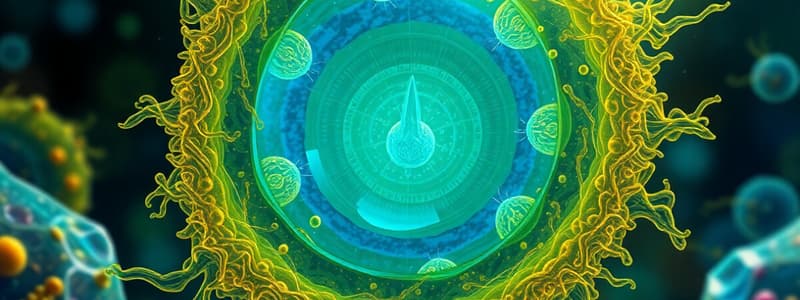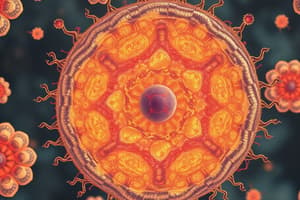Podcast
Questions and Answers
What is characteristic of each species in terms of chromosomes?
What is characteristic of each species in terms of chromosomes?
- All species have the same number of chromosomes
- Species cannot have different chromosomal arrangements
- Chromosome number is irrelevant to species classification
- Each species has a distinct characteristic number of chromosomes (correct)
Where are densely staining granules found in nondividing cells?
Where are densely staining granules found in nondividing cells?
- In the nucleolus (correct)
- In the endoplasmic reticulum
- In the cytoplasm
- In the mitochondria
What role do chromosomal numbers play in the classification of species?
What role do chromosomal numbers play in the classification of species?
- They are the primary factor in evolutionary adaptation
- They help distinguish between different species (correct)
- They influence the physical appearance of a species
- They determine the evolutionary history of a species
Which statement about the nucleolus is true?
Which statement about the nucleolus is true?
How does the number of chromosomes vary among species?
How does the number of chromosomes vary among species?
What is the approximate width of the space separating the two layers?
What is the approximate width of the space separating the two layers?
What is the diameter of the envelope pores?
What is the diameter of the envelope pores?
How do the sizes of the space between the layers and the envelope pores compare?
How do the sizes of the space between the layers and the envelope pores compare?
Which of the following best describes the relationship between the two layers?
Which of the following best describes the relationship between the two layers?
What is the role of the protein complex associated with the membrane pores?
What is the role of the protein complex associated with the membrane pores?
If the diameter of the envelope pores is 100 nm, what can you infer about their size in relation to the space between the layers?
If the diameter of the envelope pores is 100 nm, what can you infer about their size in relation to the space between the layers?
Where are the inner and outer membranes continuous?
Where are the inner and outer membranes continuous?
Which statement about the membranes is accurate?
Which statement about the membranes is accurate?
What does the term 'pore' refer to in this context?
What does the term 'pore' refer to in this context?
What is NOT a function of the protein complex lining the pores?
What is NOT a function of the protein complex lining the pores?
What is the main function of the nuclear lamina?
What is the main function of the nuclear lamina?
What components make up chromosomes?
What components make up chromosomes?
Which statement about the nuclear matrix is most accurate?
Which statement about the nuclear matrix is most accurate?
How do histones relate to chromatin?
How do histones relate to chromatin?
Which statement is true about the role of the nuclear lamina?
Which statement is true about the role of the nuclear lamina?
What is the typical length of a plant cell?
What is the typical length of a plant cell?
Which microscopy technique allows for the observation of structures not visible under a light microscope?
Which microscopy technique allows for the observation of structures not visible under a light microscope?
Which of the following is a type of electron microscopy?
Which of the following is a type of electron microscopy?
What distinguishes plant cells from other types of cells in terms of structure?
What distinguishes plant cells from other types of cells in terms of structure?
Which imaging technique is best for observing the surface of a cell?
Which imaging technique is best for observing the surface of a cell?
Which microscopy method enhances contrast without staining the sample?
Which microscopy method enhances contrast without staining the sample?
What is NOT a characteristic of plant cells?
What is NOT a characteristic of plant cells?
Which microscopy technique uses fluorescent dyes to visualize samples?
Which microscopy technique uses fluorescent dyes to visualize samples?
Which of the following best describes prokaryotic cells?
Which of the following best describes prokaryotic cells?
What is the primary function of the cytoplasm in eukaryotic cells?
What is the primary function of the cytoplasm in eukaryotic cells?
Which statement accurately describes the nucleus of eukaryotic cells?
Which statement accurately describes the nucleus of eukaryotic cells?
What is a defining characteristic of eukaryotic cells compared to prokaryotic cells?
What is a defining characteristic of eukaryotic cells compared to prokaryotic cells?
Which of the following statements about the nuclear envelope is correct?
Which of the following statements about the nuclear envelope is correct?
How many nucleoli can typically be found in a eukaryotic cell's nucleus?
How many nucleoli can typically be found in a eukaryotic cell's nucleus?
What size range is typical for a eukaryotic cell nucleus?
What size range is typical for a eukaryotic cell nucleus?
Which kingdom contains organisms that are classified as prokaryotic?
Which kingdom contains organisms that are classified as prokaryotic?
Flashcards
Separation between layers
Separation between layers
The distance between two layers.
Envelope pores
Envelope pores
Tiny openings in the envelope.
Nanometer (nm)
Nanometer (nm)
A unit of measurement for very small things.
What is Biology?
What is Biology?
Signup and view all the flashcards
What are cells?
What are cells?
Signup and view all the flashcards
What is a light microscope?
What is a light microscope?
Signup and view all the flashcards
What is primary cell structure?
What is primary cell structure?
Signup and view all the flashcards
What is an electron microscope?
What is an electron microscope?
Signup and view all the flashcards
What is ultrastructure?
What is ultrastructure?
Signup and view all the flashcards
What are prokaryotic cells?
What are prokaryotic cells?
Signup and view all the flashcards
What are eukaryotic cells?
What are eukaryotic cells?
Signup and view all the flashcards
Membrane
Membrane
Signup and view all the flashcards
Pore
Pore
Signup and view all the flashcards
Outer Membrane
Outer Membrane
Signup and view all the flashcards
Inner Membrane
Inner Membrane
Signup and view all the flashcards
Entry and Exit of Particles
Entry and Exit of Particles
Signup and view all the flashcards
Cytoplasm
Cytoplasm
Signup and view all the flashcards
Site of Metabolism (Cytoplasm)
Site of Metabolism (Cytoplasm)
Signup and view all the flashcards
Nucleus
Nucleus
Signup and view all the flashcards
Nuclear Envelope
Nuclear Envelope
Signup and view all the flashcards
Nucleolus
Nucleolus
Signup and view all the flashcards
Ribosomes
Ribosomes
Signup and view all the flashcards
Genetic Material
Genetic Material
Signup and view all the flashcards
Proteins (in Nucleus)
Proteins (in Nucleus)
Signup and view all the flashcards
Nuclear Lamina
Nuclear Lamina
Signup and view all the flashcards
Chromatin
Chromatin
Signup and view all the flashcards
Histones
Histones
Signup and view all the flashcards
Chromosomes
Chromosomes
Signup and view all the flashcards
Nuclear Matrix
Nuclear Matrix
Signup and view all the flashcards
Chromosome number in species
Chromosome number in species
Signup and view all the flashcards
Chromosome number in species
Chromosome number in species
Signup and view all the flashcards
What is the function of the nucleolus?
What is the function of the nucleolus?
Signup and view all the flashcards
What is a chromosome and its function?
What is a chromosome and its function?
Signup and view all the flashcards
Study Notes
Cell Structure
- A cell is a fundamental membrane-bound unit that makes up all living things.
- Cell size is measured in micrometres (µm).
- 1 µm = 10⁻³ mm
- A typical bacterium is 10 µm long.
- A typical animal cell is 40 µm in diameter.
- A typical plant cell is 100 µm long.
- Different types of cells use different techniques for visualization such as brightfield (stained), phase-contrast, differential interference contrast, and fluorescence.
Types of Cells
- Two types of cells exist: prokaryotic and eukaryotic.
- Prokaryotic cells are found in bacteria and cyanobacteria.
- Eukaryotic cells are found in all other organisms, including protoctista, fungi, plantae, and animalia.
Primary Cell Structure
- Primary cell structure is what can be seen using a light microscope.
- This includes the cell wall, cytoplasm, and nucleus.
Ultrastructure
- Ultrastructure refers to the structures that are visible through an electron microscope.
- Methods of electron microscopy include scanning (SEM) and transmission (TEM).
Specimen Preparation for TEM
- Specimens are prepared carefully for transmission electron microscopy.
- Steps include specimen acquisition, trimming and concentration, fixation, dehydration, infiltration with transitional solvent, infiltration with resin, and embedding and curing.
Cytoplasm
- The cytoplasm is the fluid matrix filling the cell.
- It is the site of all chemical reactions vital for life processes.
- Its ultrastructure is dynamic and complex, containing organelles and internal membrane systems.
Nucleus
- The nucleus contains genetic material.
- It can be spherical.
- It is usually surrounded by a double membrane (the nuclear envelope).
- The nuclear envelope has pores allowing for material exchange.
- It is usually 5 µm in diameter.
- A single nucleus is typically within the cell.
- The nucleus contains DNA and proteins that form chromosomes.
- One or more nucleoli are also contained in the nucleus.
- The nuclear envelope is a double membrane composed of layers separated by a small space (20-40nm)
- Nuclear pores are around 100nm in diameter.
- Protein complexes regulate the entry and exit of particles through the nuclear pores.
- The nuclear side of the membrane is lined with a network of protein filaments called the nuclear lamina maintaining the shape of the nucleus.
- Chromatin is a complex of DNA and proteins (histones), and appears as a diffuse mass in non-dividing/resting cells.
- Chromosomes contain genes that control the cell's activities by regulating protein synthesis in the cytoplasm.
Nucleolus
- The nucleolus is a densely staining granule within the nucleus, visible in non-dividing cells.
- Each cell has one or more nucleoli.
- The nucleolus is the site of ribosome production.
Studying That Suits You
Use AI to generate personalized quizzes and flashcards to suit your learning preferences.




